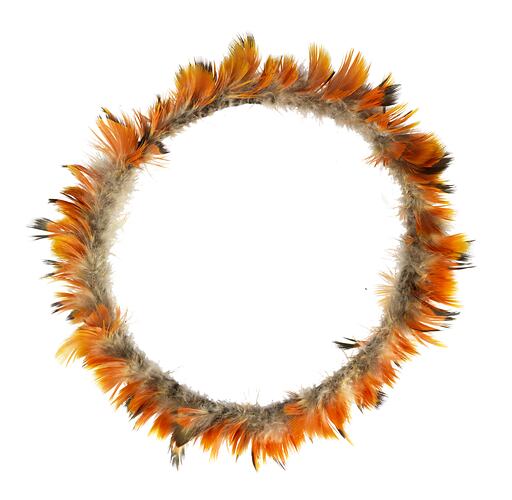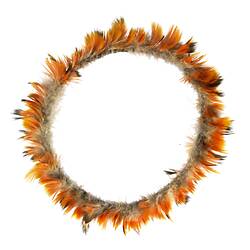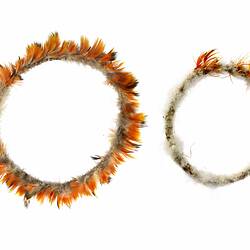Summary
Armbands and armlets were worn by men, women and children including very small ones made for babies for specific occasions. While nganybak is a generic name for armbands made from two ply string wound around a section of Flagellaria cane, Dhuwa clans use the term djali for ceremonial armbands. The parrot feathers here indicate it relates to a Dhuwa clan. Armbands like these were worn by ancestors or wangarr, who created the Arnhem Land landscape during their travels in the long ago. Feathers are incorporated into the string during the spinning process, while the string or raki is most commonly made from the softened and shredded fibres of the inner bark of the Kurrajong (Brachychiton paradoxum). String is produced by rolling two strands of the fibre along the thigh away from the body; and with a backward rolling motion, pressure is applied with the base of the hand, causing the twisted fibres to ply. The feathers are here from the red-collared lorikeet (Trichoglossus mollucanus) and this armband was most likely made to be worn during ceremony.
Local Name
djali
Physical Description
A circular armband made of cane (possibly Flagelleria sp) overwound with vegetable fibre string. Parrot feathers have been spun into the string.
More Information
-
Object/Medium
Ornament, arm
-
Maker
-
Cultural Groups
-
Locality
-
Date Produced
-
Collector
-
Date Collected
-
Object Measurements
120 mm (Length), 120 mm (Width), 20 mm (Height)
-
Classification
-
Date Made
-
Maker
-
Clan/Language Group
-
Place Made
-
Indigenous Region
-
Keywords
-
Acquisition Information
Long-term Loan from The University of Melbourne, 28 Mar 1973
-
Collection Names
-
Type of item
-
Discipline
-
Category
-
Acknowledgement
The Donald Thomson Collection. On loan to Museum Victoria from The University of Melbourne.


